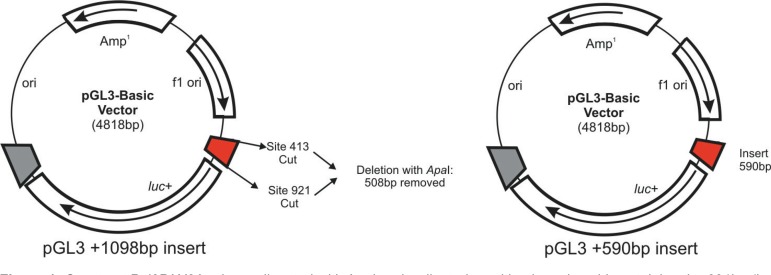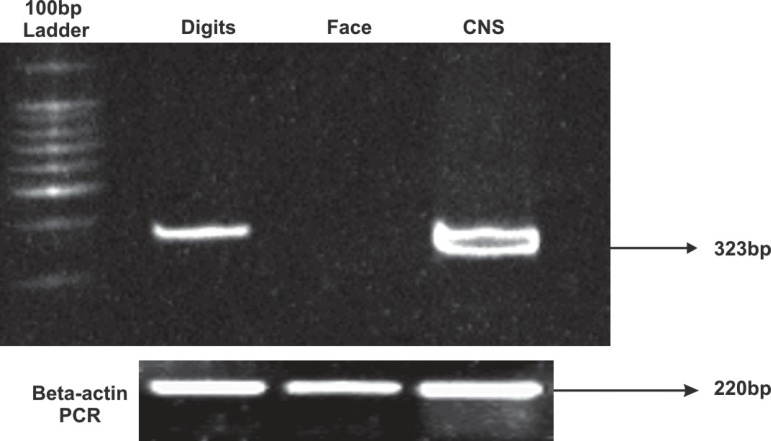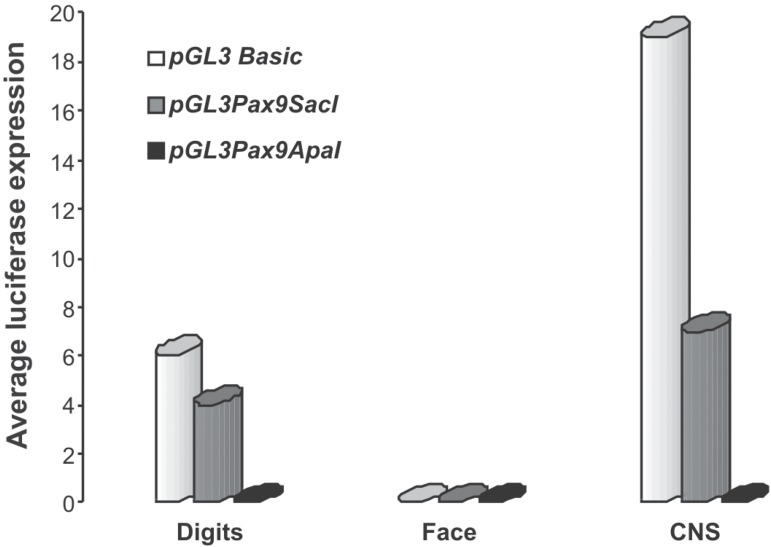Abstract
Objectives
PAX9 belongs to the Pax family of transcriptional factor genes. This gene is expressed in embryonic tissues such as somites, pharyngeal pouch endoderm, distal limb buds and neural crest-derived mesenchyme. Polymorphisms in the upstream promoter region of the human PAX9 have been associated with human non-syndromic tooth agenesis. In the present study, we verified the in vitro mRNA expression of this gene and the luciferase activity of two constructs containing promoter sequences of the PAX9 gene.
Material and Methods
Embryonic tissues were obtained from digits, face, and midbrain/hindbrain regions. Fragments containing PAX9 promoter sequences were cloned into reporter plasmids and were transfected into the different cell cultures. mRNA were extracted from primary cell cultures.
Results
The semi-quantitative RT-PCR results showed that in vitro E13.5 limb bud and CNS cells express PAX9, but cells derived from the facial region do not. Moreover, the luciferase assay showed that protein activity of the constructed vector was weaker than pgl3 -basic alone.
Conclusion
The present results suggest that the promoter sequences analyzed are not sufficient to drive PAX9 gene transcription.
Keywords: PAX9 transcription factor, Genetic promoter regions, Anodontia
INTRODUCTION
The gene PAX9 belongs to a family composed of nine genes that encode transcription factor proteins, the Pax proteins, characterized by the presence of a paired domain, and a highly conserved DNA binding region of approximately 128 amino acids1,3,13,18 and are essential during later stages of tooth development3,10,15,19. It is known that they are under the control of Fgf/Bmp signaling5.
PAX9 protein products are essential for the establishment of the odontogenic potential of mesenchyme, where the expression appears to be a marker for the sites of tooth formation due to its presence prior to any morphological manifestation of this process15. Analysis of mouse embryos has shown that PAX9 is an early marker of tooth development, appearing at the E10 stage in mesenchyme before the ectodermal thickening and prior to the expression of other tooth signaling genes. High levels of PAX9 expression are subsequently maintained throughout the initiation (E11.5), bud, and cap stages and are down regulated at the bell stage (E16)5.
The initial description of the tooth agenesis caused by the mutation in PAX9 was made by Stockton, et al.20 (2000). Since then, many others autosomal dominant mutations have been identified throughout the entire gene, the majority which being located in the paired DNA-binding domain of PAX9. Polymorphisms in the upstream promoter region of the human PAX9 have been associated with variable forms of oligodontia17, and mutations in this gene were shown to be associated with autosomal dominant forms of oligodontia in humans2,3,6,8,16,20,24. To date it is known that heterozygous deletion of entire PAX9 gene is associated with a severe form of non-syndromic tooth agenesis that involves all the primary molars and some posterior permanent teeth (premolars and molars)3,10,11,20. However, the precise mechanisms for the development of tooth agenesis remain unclear25.
Promoter mutations are known to have functionally important consequences for gene expression, but promoter analysis is not a regular part of molecular diagnostics, and one reason is that the effect of promoter mutations can be very subtle. Approximately 1% of single basepair substitutions causing human genetic diseases occur within gene promoter regions where they disrupt the normal process of gene activation and transcriptional initiation, and usually decrease or increase the level of mRNA and, thus, the protein4.
Considering that the promoter of a gene is a regulatory region of DNA, and it contains multiple sequences specifics binding sites for transcription factors, the aim of the present study was to verify the influence of promoter sequences in the transcription of PAX9 gene. Two fragments of the promoter region were cloned on reporter plasmids containing the luciferase gene and transfected into three different rat embryo tissues: digits, face and midbrain/hindbrain regions.
MATERIAL AND METHODS
Construction of Expression Plasmids
The PAX9 promoter region between positions -1209 and +92 was amplified from human DNA by PCR and subcloned into SacI-HindIII restriction sites of TOPO TA vector (Invitrogen) to generate a large number of copies for cloning into pGL3-Basic vector. The second plasmid was constructed by the pGL3-Basic-PAX9 promoter digested with ApaI restriction enzyme, resulting in a 691 bp insert (pGL3-Basic-PAX9-ApaI, -1106 to -645 and -138 to +92). In both, the +92 base was oriented to the luciferase gene (Figure 1).
Figure 1.
Construct Pgl3PAX9ApaI was digested with ApaI and re-ligated resulting in a plasmid containing the 691bp (by L. L. Ramenzoni)
Maternal and Fetal Surgical Manipulation
E0 was defined in rats, the day of sperm was found. On day 13.5, pregnant females were anesthetized with ketamine (100 mg/mL) and, following surgery, the animals were euthanized by cervical dislocation. The uterus was aseptically removed and placed in a 25 mL screw-capped tube containing 20 mL phosphate-buffered saline/D-PBS (Gibco®, Invitrogen, Carlsbad, CA, USA) and 1% antibiotic solution Antibiotic-Antimycotic liquid (100x) (Invitrogen). Embryos were dissected out of the uteri under a flow hood and transferred to a fresh dish of sterile PBS. The embryonic digits, face, and midbrain and hindbrain regions (these cells will be referred to as CNS) were placed in 35 mm cell culture dishes. The tissue fragments collected in facial region contained the maxillary and mandibular (including the dental lamina) and frontonasal processes. The cells that survived the culturing process were stellate resembling mesenchymal rather than epithelial type cells.
Experiments were performed in duplicate. The cells were grown in Dulbecco's Modified Eagle's Medium/D-MEM high glucose (Gibco®, Invitrogen) supplemented with 10% fetal bovine serum and 1% antibiotic solution Antibiotic-Antimycotic liquid (100x) (Invitrogen) and incubated at 37ºC in the presence of 5% CO2. Ethical approval was granted by the Research Ethics Committee of the Piracicaba Dental School.
mRNA analysis
After 48 h of culture, cells were homogenized and total RNA was isolated with TRIzol™ reagent, following manufacturer's instructions (Invitrogen, Carlsbad, CA, USA). cDNA was synthesized from 1 mg of total RNA using SuperScript III Reverse Transcriptase following manufacturer's instructions (Invitrogen, Carlsbad, CA, USA). DNase I digestion of RNA was performed prior to the reverse transcriptase reaction. In two independent experiments, PCR amplifications were performed using gene-specific primers for PAX9 and β-actin genes, which served as an internal control to monitor transfection efficiency. PAX9 primer sequences were PAX9Rat sense 5' (GAGTTCCATCAGCCGGATTC) and PAX9Rat antisense 5' (GATTGGAGAAGGGAGCCTTG), and rat beta actin sequences were 5' TGA CAT CCG TAA AGA CCT CT 3' (sense) and 5' AGA TGT GAT CAG CAA GCA G 3' (antisense). Polymerase chain reactions were performed on a TC-512 PCR machine (Techne Incorporated, Burlington, NJ, USA) using 5 mL of cDNA, 5 picomoles of each oligonuclotides primer, and GoTaq® Green Master (Promega Corporation, Madison, WI, USA) in a 25 μL volume. The PCR program was initiated with a 94ºC denaturation for 4 min, followed by 40 cycles of 94ºC for 1 min, 50ºC for 1 min, 72ºC for 1 min; and a final extension of 72ºC for 10 minutes for all sets of RT-PCR primers. β-actin gene amplifications were performed using primer β-actin sense 5'–TGACATCCGTAAAGACCTCT-3', and β-actin antisense 5'-AGATGTGATCAGCAAGCAG-3. The PCR program for this gene was similar previous described, but the annealing temperature used was 48ºC. Amplifications were verified in 2% agarose gels stained with ethidium bromide (10 μg/mL). The gel images were digitally captured and analyzed with the ImageJ software (available from http://rsbweb.nih.gov/ij/).
Transient transfection
Transient transfections were performed when 90-95% confluence was reached through lipofection by using Lipofectamine 2000™ reagent (Invitrogen) in the presence of Reduced Serum Medium according to the manufacturer's instructions. 0.8 µg of pGL3 Luciferase Reporter Vectors – Basic Vector (Promega Corporation) were used for a co-transfection with 0.08 µg of the pRL-CMV vector (Promega Corporation), kindly provided by Dr. Kleber Franchini from UNICAMP, for luciferase analysis normalization. Transfected cells were incubated at 37ºC in the presence of 5% CO2.
Luciferase analysis
At 48 h after transfection, cell extracts were collected and firefly and Renilla luciferase activities were measured using Dual Glo Luciferase Assay System (Promega Corporation). Briefly, 75 mL of the remaining DMEM serum-free medium were mixedwith 75 mL of Dual-Glo™ Luciferase Reagent (Promega Corporation) and incubated for 1 min. The lysates were measured for firefly luciferase activity in 96-well microplate-reading luminometer (Veritas™ Microplate Luminometer, Promega Corporation, Madison, WI, USA). Each sample was normalized to Renilla luciferase absorbance to correct for variations in transfection efficiency using 75 mL of Stop & Glo® Reagent (Promega Corporation) added to the same well and incubated for 10 min after reading. Experiments were performed in duplicate.
RESULTS
mRNA analysis
In the present experiment, a semi-quantitative assay RT-PCR was performed to measure the in vitro expression of PAX9 gene, using E13.5 rat embryonic cells in culture. The results indicated that the PAX9 gene is not expressed in face at this day, while in digits and CNS this gene is expressed (Figure 2). The presence of amplicons for the amplification of ß-actin gene validates our approach, indicating that the gene is repressed in face tissues of the analyzed embryos.
Figure 2.
PAX9 expression in rat embryos cells were detected by semi-quantitative PCR in 2% agarose with ethidium bromide
Luciferase analysis
The experiments revealed that both transfected constructions pGL3/PAX9 plasmids were not able to highly express the Luc protein. However, luciferase expression was decreased in digits and CNS transfected cells, and completely inhibited it in face transfected cells (Figure 3), supporting the mRNA analysis results.
Figure 3.
Luciferase expression and inhibition evidence in rat embryo 13.5 days of digits, face and CNS cells cultures. It can be observed that in the digits and CNS cells, the Luciferase was down expressed in pGL3PAX9SacI transfected cells, and its complete inhibition in pGL3PAX9ApaI transfected cells. In face cells, there was the complete inhibition of the Luciferase expression of all plasmids transfected cells
DISCUSSION
The dental development involves complex series of epithelial and mesenchymal signaling interactions, more than 300 genes are involved in the process22,23. Among these, transcription factors play a prominent role in the development of various organs, including teeth. To date, mutations of two of these transcription factors, which are associate with tooth agenesis, PAX0 and MSX110. While MSX1 mutations have been reported to involve cleft lip and palate5 and Witkop syndrome7, along with missing teeth, all known PAX9 mutations are associated with nonsyndromic oligodontia that can involve all types of permanent teeth, especially molars, suggesting that PAX9 plays a dominant role in the development of posterior teeth2,3,6,8,9,11,14,20,21,26. The application of different strategies in vivo and in vitro studies with mice has greatly enabled our understanding of the intricate molecular mechanisms that influence the patterning of dentition, indispensable for unraveling the genetic etiology of human tooth agenesis10. Given the role of PAX9 as a transcription factor, the mutations may affect multiple functions or processes, such as DNA-binding, nuclear translocation, transcriptional activation or synergistic protein–protein interactions with co-activators such as MSX125. Moreover, two non-coding regions which known role in increase PAX9 expression were already identified19.
pGL3PAX9SacI and pGL3PAX9ApaI constructs showed differentially transcriptional activity especially in digits and CNS cells. The analysis of the DNA biding sites on MatInspector software (available from http://www.genomatix.de/cgi-bin/eldorado/main.pl) revealed that the region of deleted in pGL3PAX9ApaI contains more than 80 putative transcriptional biding sequences, including zinc binding proteins, GATA binding factors, homeodomain transcription factors and zinc fingers kruppel-like transcription factors19
This work analyzed the PAX9 model of transcriptional regulation using the promoter sequence, as well as the capacities of this region to direct and regulates the transcriptional activity in primary cell culture derived from embryos limbs, face and central system nerve. The results demonstrated that that PAX9 gene was expressed in embryo E13.5 day limbs and CSN, but surprisingly was not expressed in cells derived from facial region. Kriangkrai, et al.12 (2006) showed that PAX9 was expressed on facial region of rats at stages E13 and E14. One possible explanation for this discrepancy is that the transcription of PAX9 was inhibited when facial cells were cultured during two days. In fact, one thing that is evidenced in studies that analyze the expression of PAX9 in mouse and rat embryonic tissues is that the expression of this gene changes rapidly during ontogeny12,15. Therefore, in vitro findings on functional properties of homeo- and paired domain proteins do not always reflect biological significance, because the network of in vivo factors determining DNA-binding specificity, protein interactions and their consequences is scarcely known25.
CONCLUSIONS
The results of the present study showed that the luciferase activity of pGL3-PAX9 constructs was weaker than pGL3-Basic vector alone, suggesting that PAX9 5' flanking sequences alone are not sufficient to drive PAX9 gene transcription and that this region might contain inhibitory cis-acting sequences. These results also indicate that enhancer sequences located in 5' sequences distant from the transcription origin or in intronic regions are necessary for PAX9 transcription.
ACKNOWLEDGEMENTS
This study was supported by the State of São Paulo Research Foundation (FAPESP), grant #98/13868-9
REFERENCES
- 1.Bailey LJ, White RP, Jr, Proffit WR, Turvey TA. Segmental LeFort I osteotomy for management of transverse maxillary deficiency. J Oral Maxillofac Surg. 1997;55(7):728–731. doi: 10.1016/s0278-2391(97)90588-7. [DOI] [PubMed] [Google Scholar]
- 2.Das P, Hai M, Elcock C, Leal SM, Brown DT, Brook AH, et al. Novel missense mutations and a 288-bp exonic insertion in PAX9 in families with autosomal dominant hypodontia. Am J Med Genet A. 2003;118A(1):35–42. doi: 10.1002/ajmg.a.10011. [DOI] [PMC free article] [PubMed] [Google Scholar]
- 3.Das P, Stockton DW, Bauer C, Shaffer LG, D'Souza RN, Wright T, et al. Haploinsufficiency of PAX9 associated with autosomal dominant hypodontia. Hum Genet. 2002;110(4):371–376. doi: 10.1007/s00439-002-0699-1. [DOI] [PubMed] [Google Scholar]
- 4.de Vooght KM, van Solinge WW. Gene promoter analysis in molecular diagnostics: do or don't? Expert Rev Mol Diagn. 2009;9(5):403–405. doi: 10.1586/erm.09.28. [DOI] [PubMed] [Google Scholar]
- 5.Fleischmannova J, Matalova E, Tucker AS, Sharp PT. Mouse models of tooth abnormalities. Eur J Oral Sci. 2008;116(1):1–10. doi: 10.1111/j.1600-0722.2007.00504.x. [DOI] [PubMed] [Google Scholar]
- 6.Frazier-Bowers SA, Guo DC, Cavender A, Xue L, Evans B, King T, et al. A novel mutation in human PAX9 causes molar oligodontia. J Dent Res. 2002;81(2):129–133. [PubMed] [Google Scholar]
- 7.Jumlongras D, Bei M, Stimson JM, Wang WF, DePalma SR, Seidman CE, et al. A nonsense mutation in MSX1 causes Witkop syndrome. Am J Hum Genet. 2001;69(1):67–74. doi: 10.1086/321271. [DOI] [PMC free article] [PubMed] [Google Scholar]
- 8.Jumlongras D, Lin JY, Chapra A, Seidman CE, Seidman JG, Maas RL, et al. A novel missense mutation in the paired domain of PAX9 causes non-syndromic oligodontia. Hum Genet. 2004;114(3):242–249. doi: 10.1007/s00439-003-1066-6. [DOI] [PubMed] [Google Scholar]
- 9.Kapadia H, Frazier-Bowers S, Ogawa T, D'Souza RN. Molecular characterization of a novel PAX9 missense mutation causing posterior tooth agenesis. Eur J Hum Genet. 2006;14(4):403–409. doi: 10.1038/sj.ejhg.5201574. [DOI] [PubMed] [Google Scholar]
- 10.Kapadia H, Mues G, D'Souza R Genes affecting tooth morphogenesis. Orthod Craniofac Res. 2007;10(4):237–244. doi: 10.1111/j.1601-6343.2007.00407.x. [DOI] [PubMed] [Google Scholar]
- 11.Klein ML, Nieminen P, Lammi L, Niebuhr E, Kreiborg S. Novel mutation of the initiation codon of PAX9 causes oligodontia. J Dent Res. 2005;84(1):43–47. doi: 10.1177/154405910508400107. [DOI] [PubMed] [Google Scholar]
- 12.Kriangkrai R, Iseki S, Eto K, Chareonvit S. Dual odontogenic origins develop at the early stage of rat maxillary incisor development. Anat Embryol (Berl) 2006;211(2):101–108. doi: 10.1007/s00429-005-0068-7. [DOI] [PubMed] [Google Scholar]
- 13.Mackenzie A, Leeming GL, Jowett AK, Ferguson MW, Sharpe PT. The homeobox gene HOX 7.1 has specific regional and temporal expression patterns during early murine craniofacial embryogenesis, especially tooth development in vivo and in vitro. Development. 1991;111(2):269–285. doi: 10.1242/dev.111.2.269. [DOI] [PubMed] [Google Scholar]
- 14.Mostowska A, Kobielak A, Biedziak B, Trzeciak WH. Novel mutation in the paired box sequence of PAX9 gene in a sporadic form of oligodontia. Eur J Oral Sci. 2003;111(3):272–276. doi: 10.1034/j.1600-0722.2003.00036.x. [DOI] [PubMed] [Google Scholar]
- 15.Neubüser A, Koseki H, Balling R. Characterization and developmental expression of Pax9, a paired-box-containing gene related to Pax1. Dev Biol. 1995;170(2):701–716. doi: 10.1006/dbio.1995.1248. [DOI] [PubMed] [Google Scholar]
- 16.Nieminen P, Arte S, Tanner D, Paulin L, Alaluusua S, Thesleff I, et al. Identification of a nonsense mutation in the PAX9 gene in molar oligodontia. Eur J Hum Genet. 2001;9(10):743–746. doi: 10.1038/sj.ejhg.5200715. [DOI] [PubMed] [Google Scholar]
- 17.Peres RC, Scarel-Caminaga RM, Espírito Santo AR, Line SR. Association between PAX-9 promoter polymorphisms and hypodontia in humans. Arch Oral Biol. 2005;50(10):861–871. doi: 10.1016/j.archoralbio.2005.02.003. [DOI] [PubMed] [Google Scholar]
- 18.Peters H, Balling R. Teeth. Where and how to make them. Trends Genet. 1999;15(2):59–65. doi: 10.1016/s0168-9525(98)01662-x. [DOI] [PubMed] [Google Scholar]
- 19.Santagati F, Abe K, Schmidt V, Schmitt-John T, Suzuki M, Yamamura K, et al. Identification of Cis-regulatory elements in the mouse Pax9/Nkx2-9 genomic region: implication for evolutionary conserved synteny. Genetics. 2003;165(1):235–242. doi: 10.1093/genetics/165.1.235. [DOI] [PMC free article] [PubMed] [Google Scholar]
- 20.Stockton DW, Das P, Goldenberg M, Stockton DW, Das P, Goldenberg M, D'Souza RN, Patel PI. Mutation of PAX9 is associated with oligodontia. Nat Genet. 2000;24:18–19. doi: 10.1038/71634. [DOI] [PubMed] [Google Scholar]
- 21.Tallón-Walton V, Manzanares-Céspedes MC, Arte S, Carvalho-Lobato P, Valdivia-Gandur I, Garcia-Susperregui A, et al. Identification of a novel mutation in the PAX9 gene in a family affected by oligodontia and other dental anomalies. Eur J Oral Sci. 2007;115(6):427–432. doi: 10.1111/j.1600-0722.2007.00492.x. [DOI] [PubMed] [Google Scholar]
- 22.Thesleff I. Developmental biology and building a tooth. Quintessence Int. 2003;34(8):613–620. [PubMed] [Google Scholar]
- 23.Thesleff I. The genetic basis of tooth development and dental defects. Am J Med Genet A. 2006;140(23):2530–2535. doi: 10.1002/ajmg.a.31360. [DOI] [PubMed] [Google Scholar]
- 24.van den Boogaard MJ, Dorland M, Beemer FA, van Amstel HK. MSX1 mutation is associated with orofacial clefting and tooth agenesis in humans. Nat Genet. 2000;24(4):342–343. doi: 10.1038/74155. [DOI] [PubMed] [Google Scholar]
- 25.Wang Y, Wu H, Wu J, Zhao H, Zhang X, Mues G, et al. Identification and functional analysis of two novel PAX9 mutations. Cells Tissues Organs. 2009;189(1-4):80–87. doi: 10.1159/000151448. [DOI] [PMC free article] [PubMed] [Google Scholar]
- 26.Zhao JL, Chen YX, Bao L, Xia QJ, Wu TJ, Zhou L. Novel mutations of PAX9 gene in Chinese patients with oligodontia. Zhonghua Kou Qiang Yi Xue Za Zhi. 2005;40(4):266–270. [PubMed] [Google Scholar]





